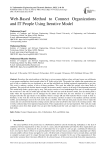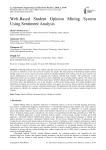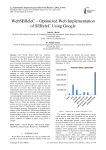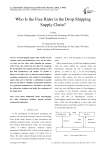- Все статьи 584
Статьи журнала - International Journal of Information Engineering and Electronic Business
Все статьи: 584

Web-Based Method to Connect Organizations and IT People Using Iterative Model
Muhammad Aqeel, Muhammad Imtiaz, Muhammad Sikander Shahbaz
Статья научная
Nowadays the actual problem is that there is not any proper platform where software houses can collaborate or any proper marketplace where people related to IT fields can get jobs. The people fear whether the organizations are real or fake or whether they are registered or not and the individuals are finding registered organizations to get jobs. This work is making a project to solve all these problems. This work has made this project solve these kinds of problems. This project has used the iterative model, the iterative model is used to do all steps of development iteratively. This model helps make a project step by step. This project consists of two breakthroughs first one is a mobile app and the second one is the web. In mobile apps and the web, this work has used the Iterative model, first, the admin panel is made where the organizations can be managed by the admin and after that, the user interface of a mobile app is designed and then the app relates to the database which is mongo dB and with backend which is made in node Js. Similarly, on the web, this work has first made the user interface and then it relates to the database and back end like mobile, and technologies used on the web are the same as mobile. This work has done great research work to make this system and our system better than the existing systems and has removed all flaws that were in the existing systems. This work has collected data from registered organizations. These organizations are real and registered. This work also made a feedback system from their people who can give their feedback and this work can improve our system according to their needs.
Бесплатно

Web-Based Student Opinion Mining System Using Sentiment Analysis
Olaniyi Abiodun Ayeni, Akinkuotu Mercy, Thompson A.F., Mogaji A.S.
Статья научная
Collecting feedback from a few students after the exams has been the norm in educational institutions. Forms are given to students to assess the course the lecturer has taught. The main purpose of developing student opinion mining system is to create a faster and easier method of collecting feedback from student, and also give lecturers and school administrators an easier way of analysing the feedback collected from students. The significance of this application is that it is less expensive and present a more confidential way of getting students opinion. The major tools used in developing this application are Python, Scikit learn, Textblob, Pandas and SQLite.. Django provides an in-built server that allows the application to run on the localhost.. In this project dataset gotten from online feedback form distributed to students was used for the sentiment analysi ,Chi-square was used for feature selection and the support vector machine algorithm was used for sentiment classification. The application will help the university administrators and lecturers to identify the strengths and weaknesses of the lecturer based on the textual evaluation made by the students.
Бесплатно

WebSEReleC – Optimized Web Implementation of SEReleC Using Google
Vishwas J Raval, Padam Kumar
Статья научная
The World Wide Web has immense resources for all kind of people for their specific needs. Searching on the Web using search engines such as Google, Bing, Ask have become an extremely common way of locating information. Searches are factorized by using either term or keyword sequentially or through short sentences. The challenge for the user is to come up with a set of search terms/keywords/sentence which is neither too large (making the search too specific and resulting in many false negatives) nor too small (making the search too general and resulting in many false positives) to get the desired result. No matter, how the user specifies the search query, the results retrieved, organized and presented by the search engines are in terms of millions of linked pages of which many of them might not be useful to the user fully. In fact, the end user never knows that which pages are exactly matching the query and which are not, till one check the pages individually. This task is quite tedious and a kind of drudgery. This is because of lack of refinement and any meaningful classification of search result. Providing the accurate and precise result to the end users has become Holy Grail for the search engines like Google, Bing, Ask etc. There are number of implementations arrived on web in order to provide better result to the users in the form of DuckDuckGo, Yippy, Dogpile etc. This research proposes development of a meta-search engine, called WebSEReleC (Web-based SEReleC) that provides an interface for refining and classifying the search engines' results so as to narrow down the search results in a sequentially linked manner resulting in drastic reduction of number of pages using power of Google.
Бесплатно

Who Is the Free Rider in the Drop-Shipping Supply Chain?
Li Feng, Tu Yijian, Guo Xiaolong
Статья научная
In Drop-shipping supply chain, retailers get the customer orders and manufacturers carry out the orders. Are there any free riders while obtaining the customer order? If any, who could be the free riders? By comparing the decentralized and centralized decision making, we find that both manufacturers and retailers are possible to behave as free riders. Also, we study the contract designs to coordinate manufacturers and retailers in Drop-shipping supply chain, and we find that a combination of quantity discount and delivery reliability compensation mechanism as to guarantee manufacturers a safe delivery can achieve the bi-direction excitation, and finally the coordination of the supply chain.
Бесплатно

